

Forgotten Filipino Warriors
of Freedom
by Conrado (Sluggo) Rigor, Jr. / Filipino-American
Bulletin, Seattle, WA.
The Forgotten Heroes
Artist: Ronald Recaido
The recent awarding of the
U.S. Congressional Medal of Honor to Filipino WWII veterans has been hailed far
and wide. Seven decades later, accolades in the form of replicated medals are
given posthumously to families of thousands. The surviving few still participate
in ceremonies but are no longer lucid nor aware what the rituals are about. As a
veteran’s son, I am often invited to events honoring families of the departed
and a few still-living WWII veterans. It is heartbreaking to witness such
ceremonies. Solemn and profound with eloquent speeches by dignitaries, the
programs make sure there is hardly a dry eye when the roll calls start and the
bugle plays. Awed by the salutes and splendor, the audience remember the
warriors of freedom who are no longer around. To see once-proud soldiers on
stage---surviving well into their 90s, each one on a wheelchair, no longer able
to understand, hear nor appreciate the ceremony extolling them is in itself an
emotional experience.
**
The senior center where I work is a virtual
repository of WWII veterans’ files especially those who had come to the U.S. to
become citizens. Since the 1990s, Filipino WWII veterans of varied stripes who
chose to settle down in the Northwest gravitated towards the senior center in
Seattle. Many fought in the Pacific War as servicemen in the Philippine
Commonwealth Army, as recognized civilian guerillas, or as Philippine Scouts.
When the International Drop-In Center (IDIC) invited the old soldiers in 2004 to
relocate their small table to IDIC’s Beacon Hill office, they had by then
organized themselves as the Filipino War Veterans of Washington (FWVW). The
Commander at that time was an Ilocano guerillero, Julio Joaquin. Working closely
with Manong Julio, IDIC offered the group a room to be their official
headquarters, an offer approved by the IDIC Board which the old soldiers happily
accepted. I helped design their white gala uniform, designed their overseas cap,
designed and produced the FWVW officers’ business cards. As adviser to the FWVW,
I interviewed each one and learned about their sad plight. Thousands had arrived
in the U.S. alone because Uncle Sam had legislated that only the Filipino
veteran could come if he wished to be a citizen. They had believed that they
would also receive long-awaited WWII service pensions. In 1990 then President
George H. Bush had signed an Executive Order allowing WWII Filipino soldiers to
come to the U.S. to swear allegiance as citizens. Majority of those who came
were mostly economically-challenged ex-guerillas and enlisted men. There was
hardly anyone with a rank higher than a lieutenant. (Another intriguing account
explained by higher-ranking Filipino veterans.) Already in their mid and early
70s, many were culture-shocked, coming mainly from provincial parts of the
Philippines. Worst of all, majority were unemployable due to age and lack of
local experience. So IDIC had to arrange for them to receive SSI (supplemental
security income), a monthly subsidy enough for an unemployed senior citizen to
survive. In order for them to petition their wives and children, the veterans
had to prove that they had income. Again it was IDIC that referred them to
menial jobs to comply with immigration laws that will allow petitions to be
filed. It was heartbreaking to see old, frail warriors working in sweat shops as
janitors, laundry aides, dishwashers, kitchen aides, sharing tiny rooms at the
International District and scrimping on rent and food. Of course they were hurt
and angry but could not complain. Many shed tears and shared their agony with
us. To be able to save a little to send to their families back home and to
officially record them as employed and therefore eligible to file petitions, the
aging WWII warriors felt that their dignity was trampled upon and that no one
cared.
**
Beginning in 2005 IDIC (www.idicseniorcenter.org)
advocated in earnest for the old soldiers by affiliating with local and national
organizations. It turned out that their plight was duplicated in major parts of
the U.S. like San Francisco, Los Angeles and Honolulu. They had wisely chosen to
stay in warmer regions. In Seattle, the FWVW had 300 active members in the
beginning. Aside from veterans living in the Bush Hotel and subsidized apartment
facilities in Chinatown, others lived in King, Pierce and Kitsap counties. To
get to know them better, IDIC conducted a survey focusing on their most critical
needs. The result was heart-rending. As expected, all wanted their families to
join them in the U.S. Based on the unprecedented survey that was conducted in
Western Washington by virtue of a one-time grant from Governor Christine
Gregoire, official endorsements came from the Washington State Veterans Affairs
Office (VAO) and the Olympia-based Council of Asian Pacific American Affairs
(CAPAA). IDIC worked closely with then CAPAA Chair Ellen Abellera who made the
veterans’ plight a single-minded focus. It was the first time that a community
group would help make known the foremost desire of aging Filipino soldiers who
lived alone in America. Although there was then a high-profile national campaign
led by Washington DC-based Eric Lachica’s American Coalition for Filipino
Veterans (ACFV) and the National Federation of Filipino-American Associations
(NaFFAA) of the late Alex Esclamado to seek pension benefits for Filipino WWII
veterans as de facto wartime recruits of the U.S. Army, the old soldiers still
loudly voiced their preference for their families to join them in the U.S. At
that conference in Washington DC, there emerged a heated argument whether family
reunification should be given equal push like that of the pension issue. I
remember that the majority of veterans under Eric Lachica’s ACFV almost walked
out of the Embassy after they were turned down. If not for PH Ambassador Jose
Gaa’s appeal, the old soldiers---who really wanted their families more than the
much-delayed pension bill---would have jeopardized the conference. Unbeknownst
to the public, it was the FWVW’s and IDIC’s strategic leadership that launched
what became known (and still actively pursued) as the Filipino WWII Veterans’
Family Reunification Program. Current FWVW Commander Greg Garcia is officially
credited for the initiative and consequent recognition by Filipino veterans’
groups all over the U.S. It was Manong Greg’s position paper, prepared with the
help of IDIC, that was roundly applauded by veterans, their widows and children
in Honolulu during a NaFFAA national conference. A few months later Commanders
Montero and Garcia, with their spouses, attended a command conference in
Washington DC organized by the Philippine Embassy and the National Federation of
Filipino-American Associations (NaFFAA) to address the pending veterans’ pension
bill. I was privileged to be part of the delegation. That historic conference of
aging Filipino soldiers living in the U.S. was highlighted by meetings with the
late U.S. Senators Daniel Inouye and Daniel Akaka. And there was the
unforgettable five-minute testimony delivered by Filipino WWII hero of the Nueva
Ecija Great Raid, Lt. Benito Valdez, before the U.S. Congressional Veterans’
Affairs Committee in Washington DC. In a trembling voice and holding back tears,
Manong Benito appealed for family reunification before a hushed audience. After
that emotional speech, U.S. Senator Patty Murray, a member of the Committee, was
so touched that she stepped down from her chair to embrace Manong Benito. She
declared how proud she was that a war hero from her home State was performing
one more heroic act on behalf of his aging comrades. Two years later the lady
Senator was instrumental in arranging for the children and grandchildren of
Manong Benito---who was then on his deathbed---to come to the U.S. just in time
before he died at age 91.
**
Today, the promised reunification of veterans’
families is bogged down in bureaucratic maze. Scores of poor aging soldiers,
sickly and invalid Filipino-Americans, still wait for their children, many
granted temporary status as virtual visitors. The best that Uncle Sam could do
for Filipino WWII veterans was to award them a one-time lump sum pension
(conveniently timed with the Obama stimulus drive to jumpstart a lethargic
economy). And given only to those who are still living. Those who have died
waiting, even if they are listed in official rosters in U.S. military archives,
their widows and families do not get anything! To address the family issue,
petitioned families waiting for visa numbers are selectively given what is known
as a parole agreement. Parole visas, renewed every three years and issued by the
U.S. INS are very limiting because the aging veterans’ children can come to the
U.S. but are not allowed to hold permanent jobs. They must wait until their visa
numbers come up before qualifying for a green card that signifies permanent
residence. Which could take another decade! Meanwhile, if their fathers should
die while waiting, the petition could be annulled. What a deal! The situation
calls for an advocate in the U.S. Government to pick up the cudgels once again
for the remaining forgotten and aging warriors. It is a situation that is not
known to the general public, both in the U.S. and in the Philippines. Amidst all
of the glorious medal-awarding ceremonies, we hope that the old soldiers’
supporters can take another serious look at this sad and ironic situation.
**
U.S.-based Filipino WWII advocacy groups like the
FilVetREP are doing an admirable job at drawing attention on heretofore unknown
fragments in the continuing saga of the forgotten warriors. When the glorious
medal-awarding ceremonies are over, the next sequel will be an educational
program to perpetuate the sacrifices and valor of the Filipino soldier in WWII.
Among the supportive organizations that are proposing to fund a Professorial
Chair in the University of the Philippines’ Department of History is the Beta
Sigma Fraternity of the Pacific Northwest. Fraternity officers have met with
Prof. Rico Jose in Diliman, Quezon City to propose an academic research and
Professorial Chair to study the role of Filipino soldiers in helping win the
Pacific War. Because that part of our history is a personal matter to me and my
siblings, I have long immersed myself in research and advocacy work even before
I migrated to the U.S. All gone now---my father, my father-in-law, two of my
mother’s brothers, and three other close uncles---were soldiers who fought in
WWII. In my youth, growing up in the old Camp Murphy and then at historic Ft.
William McKinley in Taguig with fellow-Army brats (children of Philippine
military officers), I had been a member of the Sons & Daughters of the Defenders
of Bataan and Corregidor (DBC) which was envisioned by General Dionisio Ojeda to
be a generation of caretakers of our fathers’ legacies.
**
My father’s comrades had shared awesome tales about
the war and lamented how pitifully lacking post-war records are in mentioning
the role of the Filipino soldier in crucial encounters and bloody battles
against the enemy. They were disappointed to discover that After-Battle Reports
on military operations in the Philippine archipelago were based mainly on
American records, viewpoints and writings. There were hardly any wartime reports
from Filipino sources. It was explained that the country was under the Japanese
for three long years and most operations were conducted underground. It was
foolish, they reasoned, to have maintained any paperwork in that situation.
Other Filipino officers held the view that WWII happened at a time when racial
prejudice was raging in the U.S. and Filipino soldiers were condescendingly
looked upon as the Little Brown Brothers. Service records do show that Filipino
recruits in the U.S. were assigned mostly as ammo carriers, air cargo cleaners,
latrine and kitchen crews, bootblacks, battleship rust scrapers, utility and
laundry aides. Contrary to dramatized post-war tales, there were not many who
saw actual combat. In the Philippines, young soldiers in their early 20s
recruited by General MacArthur to form the Commonwealth Army bore the brunt in
defending the country from the invading Japanese. Respected Filipino military
historians and academic researchers like the University of the Philippines’
Department of History Professor Rico Jose are among those who can help establish
true accounts during WWII in the Philippines from oral and written testimonies.
There are first-hand accounts of the war in a book written by the respected
College Editors Guild (CEG) founder Ernesto Rodriguez Jr., “The Bad Guerillas of
Northern Luzon.” Or the book authored by U.S. Army Gen. Jonathan Wainwright, “We
Remained,” considered a classic tweak to another General’s “I Shall Return”
promise.
**
Generations of Filipinos and the youth in schools
must one day be able to read true accounts of how their forebears helped win the
cause of freedom in the Pacific War. Seven decades later, it should become every
Filipino’s wish to memorialize genuine accounts of that war---especially the
crucial engagements where Filipino soldiers wrapped themselves in glory and
displayed uncommon valor, thousands paying the ultimate price. Research about
brave, selfless Filipino men and women, written by Filipinos for Filipinos
should be a guiding element. Because war holds many truths, it becomes our
solemn duty as a people to be discerning, to set apart what are genuinely ours.
We must distinguish the glory claimed by others from those that rightfully
belong to Filipino patriots. #
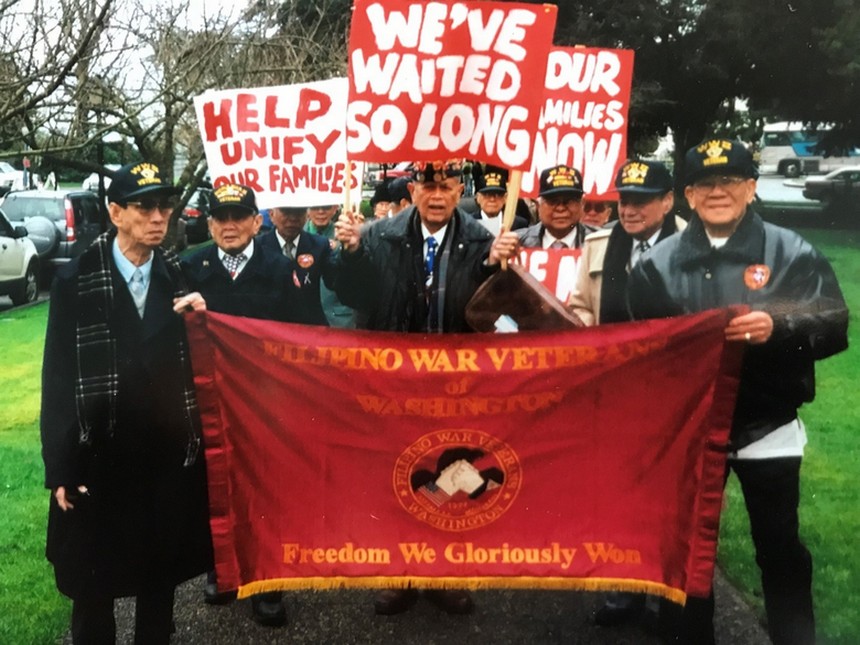
In 1996 aging WWII veterans rallied in Olympia, seat of Washington State government, to seek help in their campaign for family reunification.
The group was led by Commanders Julio Joaquin and Amador Montero (2nd and 3rd from left). Both have passed away.
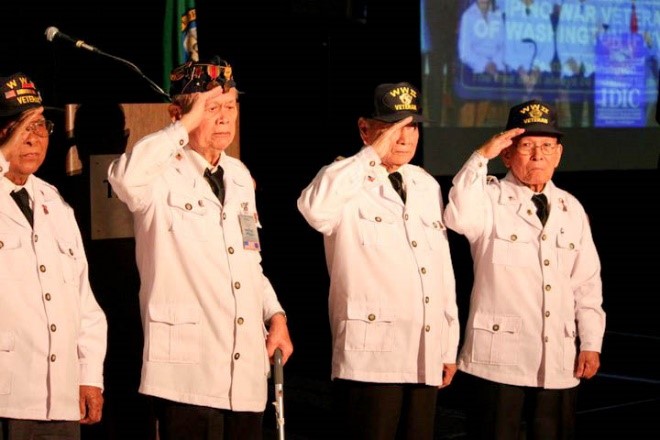
Filipino WWII Veterans of Washington (FWVW) at a
formal ceremony honoring them in Seattle.
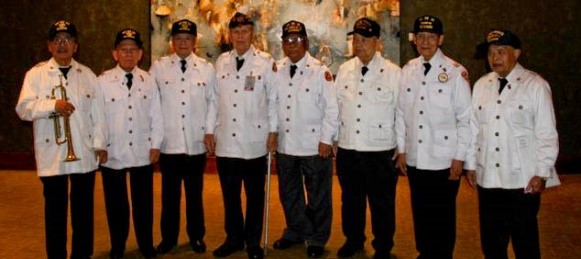
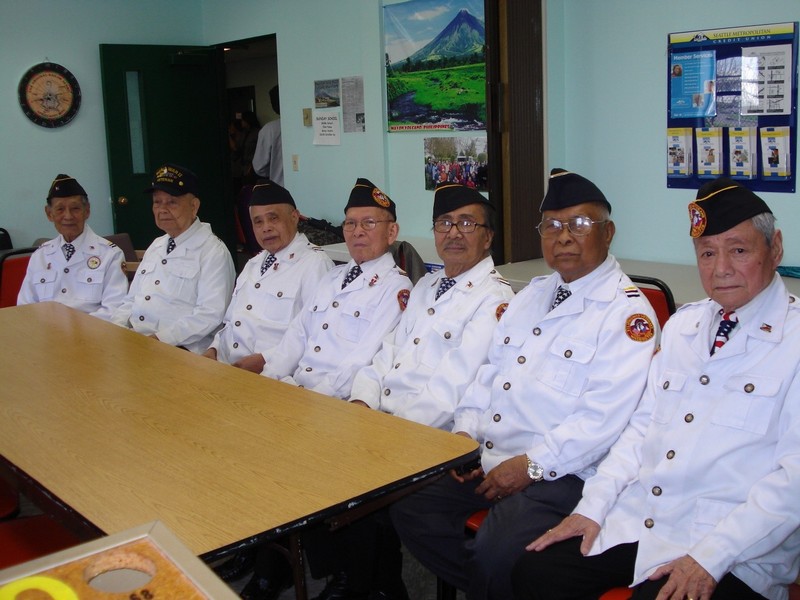
MABUHAY KAYO !!
About the Author
Conrado N. Rigor, Jr. is executive director of a
non-profit human services organization (www.idicseniorcenter.org) based in
Seattle. Sluggo is a community journalist who also served as information attache in
Seattle’s Philippine Consulate General in the late 1980s. He is the eldest son
of a WWII veteran who had figured in the historic Battle of Bessang Pass where
General Yamashita and his invaders finally surrendered to end the Pacific War.
His email: sluggorigor@gmail.com.
About the Artist
Ronald Recaido is a Bachelor of Fine Arts graduate from California State University, Long Beach. Ron, whose father is a retired navyman, is in active service in the United States Navy. His email: recaido77@gmail.com.
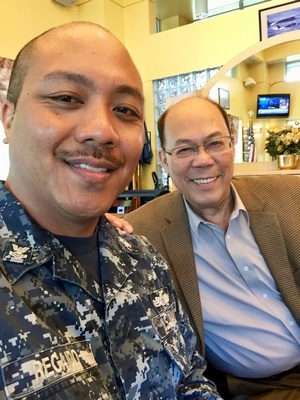
Ron and Sluggo, in Seattle 2015